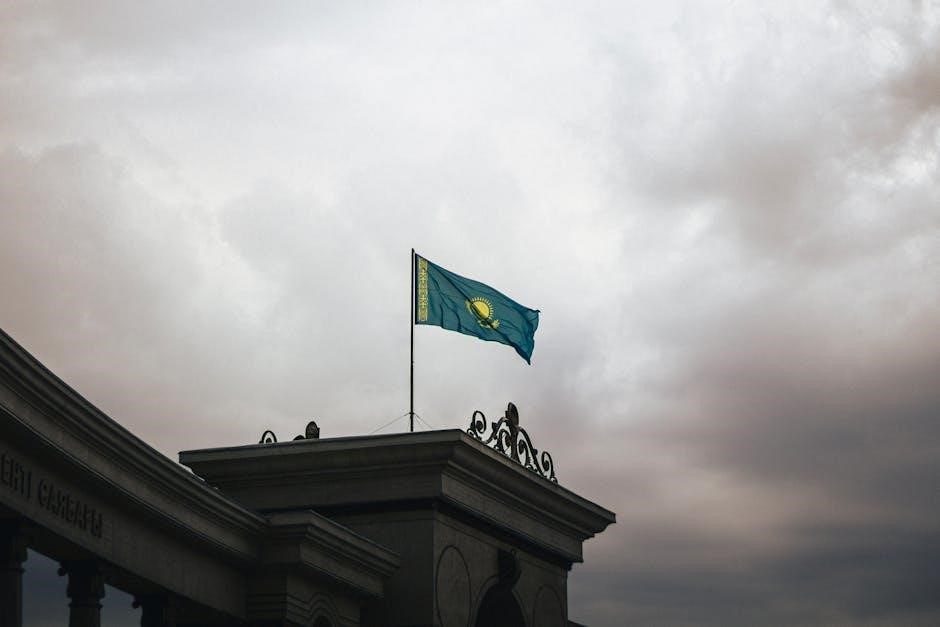The Ceremonial of Bishops is the official liturgical guide for bishops, outlining rituals and ceremonies such as confirmations and ordinations. It serves as a model for liturgical celebrations, emphasizing unity and tradition in the Catholic Church.
1.1 Definition and Overview
The Ceremonial of Bishops, or Caeremoniale Episcoporum, is the official liturgical document guiding Catholic bishops in conducting sacred rites. Published in Latin, it outlines proper protocols for ceremonies like confirmations, ordinations, and episcopal consecrations. This document ensures consistency and dignity in liturgical practices, reflecting the Church’s tradition and unity. Available in translated editions, it serves as a vital resource for bishops, masters of ceremonies, and liturgical offices. The Ceremonial of Bishops is also accessible in PDF formats, making it widely available for study and reference. Its detailed instructions and historical context provide a comprehensive framework for understanding episcopal liturgical duties.
1.2 Historical Context
The Ceremonial of Bishops traces its origins to the 17th century, with the first official publication in 1886. It was revised extensively after the Second Vatican Council to align with liturgical reforms. This document reflects centuries of tradition, providing a structured framework for episcopal ceremonies. Its historical evolution ensures that modern practices remain rooted in the Church’s heritage. The Ceremonial of Bishops has been translated into multiple languages and is widely distributed, including in PDF formats, making it accessible for global use. It remains a cornerstone for understanding the liturgical role of bishops and their ceremonial duties, preserving the richness of Catholic liturgical tradition.
1.3 Importance in Liturgical Practices
The Ceremonial of Bishops holds significant importance in liturgical practices as it provides a standardized framework for episcopal ceremonies. It ensures consistency and dignity in the celebration of Mass, sacramental rites, and other liturgical events. By adhering to the guidelines outlined in the Ceremonial, bishops and liturgical ministers maintain the integrity and unity of the Church’s traditions. This document serves as a vital reference for proper liturgical conduct, emphasizing the symbolic and spiritual dimensions of episcopal roles. Its detailed instructions and historical insights make it an indispensable resource for both education and practical application, fostering a deeper understanding of liturgical practices within the Catholic Church.

Historical Background of the Ceremonial of Bishops

The Ceremonial of Bishops traces its origins to the early Church, evolving through centuries of liturgical practices. Initially published in 1886, it was revised post-Vatican II to reflect modern liturgical reforms, ensuring its relevance as a guiding document for episcopal ceremonies.
2.1 Origins and Development
The Ceremonial of Bishops has its roots in ancient liturgical traditions, with early manuscripts detailing episcopal rites. Over centuries, it evolved to include various ceremonies such as ordinations and consecrations. The first official publication in 1886 formalized these practices, establishing a standardized guide for bishops. This foundational document underwent significant revisions after the Second Vatican Council, aligning it with modern liturgical principles. The development reflects the Church’s adaptability while preserving sacred traditions, ensuring the Ceremonial remains a vital resource for episcopal liturgical practices.
2.2 Key Editions and Revisions
The Ceremonial of Bishops has undergone several significant editions and revisions. The first official publication in 1886 established standardized liturgical practices for bishops. A major revision followed the Second Vatican Council, aligning the text with contemporary liturgical reforms. In 1989, a revised edition was released, incorporating updated rituals and clarifications. A notable revision in 2011 further refined the document, ensuring consistency with post-conciliar liturgical norms. Each edition reflects the evolving needs of the Church while preserving the rich tradition of episcopal ceremonies. These revisions ensure the Ceremonial remains a relevant and authoritative guide for bishops worldwide.
2.3 Influence of Vatican II
The Second Vatican Council profoundly impacted the Ceremonial of Bishops, leading to a comprehensive revision of its content and structure. Vatican II’s emphasis on liturgical renewal prompted the Church to modernize episcopal rituals, making them more accessible and participatory. The Council’s decrees introduced changes such as the use of vernacular languages and a focus on the universal Church. These reforms were incorporated into the Ceremonial, ensuring that episcopal ceremonies aligned with the Council’s vision of a more engaged and unified Church community. The revised document reflects Vatican II’s principles, blending tradition with contemporary pastoral needs to enhance the liturgical life of the Church.

Structure and Contents of the Ceremonial
The Ceremonial of Bishops is organized into eight divisions, covering liturgical celebrations, governance rites, and detailed guidelines for episcopal ceremonies. It provides clear instructions for bishops, ensuring consistency and reverence.
3.1 Organization of the Document
The Ceremonial of Bishops is structured into eight distinct sections, each addressing specific liturgical practices and episcopal duties. The document begins with an introduction to its purpose and significance, followed by detailed chapters on various ceremonies such as Mass, sacramental celebrations, and processions. Each section is further divided into subsections, providing clear guidelines for bishops and liturgical ministers. The organization ensures that the document is both comprehensive and accessible, serving as a practical reference for liturgical planning and execution. This systematic approach reflects the importance of order and tradition in the Catholic Church’s liturgical practices.
3.2 Detailed Ceremonies and Rites
The Ceremonial of Bishops provides meticulous instructions for various liturgical ceremonies, including the consecration of bishops, ordinations, and the celebration of Mass. It outlines the proper protocols for processions, the use of incense, and the roles of deacons and other ministers. Specific rites, such as the imposition of hands and the exchange of peace, are described in detail to ensure adherence to tradition. The document also addresses the symbolic significance of vestments, such as the mitre and crozier, emphasizing their role in representing episcopal authority. These detailed guidelines ensure that ceremonies are conducted with reverence and consistency, reflecting the rich liturgical heritage of the Catholic Church.
3.3 Liturgical Norms and Guidelines
The Ceremonial of Bishops outlines comprehensive liturgical norms and guidelines essential for maintaining consistency in episcopal ceremonies. It provides detailed instructions on the proper conduct of liturgical celebrations, ensuring reverence and adherence to tradition. The document covers the correct use of liturgical vestments, such as the mitre and crozier, and the roles of masters of ceremonies and other officials. Specific protocols are outlined for processions, incense usage, and the involvement of deacons and presbyters. These guidelines ensure uniformity across dioceses, reflecting the Church’s commitment to preserving its rich liturgical heritage. By following these norms, bishops and their assistants can uphold the spiritual integrity and ceremonial dignity of the Church’s rituals.

Role of Bishops in Ceremonial Practices
Bishops play a central role in liturgical celebrations, presiding over sacred rites and ensuring ceremonial integrity. Their leadership embodies the Church’s traditions and spiritual authority, guiding communal worship with reverence and precision.
4.1 Leadership in Liturgical Celebrations
Bishops serve as spiritual leaders in liturgical celebrations, ensuring ceremonies align with sacred traditions. They preside over rites like Mass, ordinations, and confirmations, guiding participants with authority and reverence. Their role is crucial in maintaining the integrity of rituals, fostering unity among the faithful. By adhering to the Ceremonial of Bishops, they model liturgical practices for clergy and laity, emphasizing the Church’s continuity and the divine presence in worship. This leadership not only upholds liturgical norms but also inspires devotion, making bishops pivotal figures in the spiritual life of the Church.
4.2 Symbolism and Significance
The Ceremonial of Bishops is rich in symbolism, reflecting the bishop’s role as a spiritual shepherd. Rituals like the use of the mitre and crozier emphasize authority and guidance. These symbols connect the bishop to Christ, the Good Shepherd, and highlight the Church’s unity. The ceremonies underscore the bishop’s dual role as a teacher and a sanctifier, while also showcasing the continuity of apostolic tradition. Through these liturgical practices, the bishop embodies the Church’s mission, fostering devotion and inspiring the faithful to deepen their spiritual lives. The symbolism reinforces the sacred nature of episcopal ministry and its enduring significance in Catholic worship and tradition.
4.3 Responsibilities and Duties
Bishops hold sacred responsibilities, including presiding over sacraments like ordination and confirmation. They are tasked with consecrating churches, blessing altars, and leading liturgical celebrations. As spiritual leaders, bishops guide their flock, uphold doctrine, and ensure the faithful adhere to Church teachings. Their duties include governing dioceses, appointing clergy, and overseeing parish activities. They also serve as mediators and peacemakers, promoting unity within the Church. These responsibilities are carried out with dignity and reverence, reflecting their role as successors to the apostles. Bishops are also expected to embody moral integrity, inspiring the faithful through their actions and teachings. Their duties are central to maintaining the spiritual and administrative life of the Church.

Liturgical Practices and Rituals
The Ceremonial of Bishops provides detailed guidance for liturgical practices, including Mass, sacraments, and processions. It outlines the proper use of vestments and ritualistic gestures, ensuring reverence and order in worship.

5.1 Mass and Sacramental Celebrations
The Ceremonial of Bishops meticulously outlines the proper conduct of Mass and sacramental celebrations, emphasizing the bishop’s role as the chief liturgical minister. It provides detailed rubrics for the celebration of the Eucharist, including the use of incense, processions, and the proper wearing of liturgical vestments. Specific guidance is offered for sacraments such as Confirmation and Holy Orders, ensuring the rites are performed with dignity and reverence. The document also addresses the bishop’s responsibilities in presiding over these ceremonies, highlighting the importance of maintaining tradition while fostering active participation among the faithful. This section serves as a comprehensive guide for bishops to uphold the sacredness and unity of liturgical practices within the Church.
5.2 Use of Vestments and Regalia
The Ceremonial of Bishops extensively details the proper use of liturgical vestments and regalia, emphasizing their symbolic significance. Bishops wear specific attire such as the mitre, crozier, and pectoral cross, which signify their office and spiritual authority. The document outlines the appropriate vestments for various ceremonies, ensuring consistency and reverence. It also explains the correct manner of donning and removing these items, reflecting the dignity of the episcopal office. The use of regalia is closely tied to the liturgical context, ensuring that each piece serves as a visual reminder of the bishop’s role in leading the Church’s sacramental life.
5.3 Processions and Ceremonial Acts
Processions and ceremonial acts in the Ceremonial of Bishops are meticulously structured to reflect the dignity and solemnity of episcopal liturgies. These processions, often led by the bishop, involve precise ordering of participants, including clergy, deacons, and acolytes. The document provides detailed instructions for movements, gestures, and timing, ensuring a reverent and unified celebration. Ceremonial acts, such as the bishop’s entrance, the use of incense, and the recessional, are outlined to emphasize the sacred nature of the occasion. These rituals not only enhance the liturgical experience but also foster a sense of communal worship and devotion among the faithful.

Significance of the Ceremonial in the Church
The Ceremonial of Bishops preserves sacred traditions, ensuring unity in liturgical practices. It serves as a guiding document for bishops, fostering reverence and consistency in church ceremonies and governance.
6.1 Unity and Tradition
The Ceremonial of Bishops is a cornerstone of liturgical unity, ensuring consistency across dioceses. Rooted in centuries of tradition, it preserves the rich heritage of Catholic liturgy, guiding bishops in maintaining authenticity and continuity. By adhering to its guidelines, the Church fosters a universal sense of worship, transcending local customs. This unity strengthens the global Catholic community, reflecting the Church’s timeless values. The document emphasizes the importance of shared rituals, reinforcing the bond among believers. Through its detailed prescriptions, the Ceremonial safeguards the traditions passed down through generations, ensuring that liturgical practices remain faithful to their historical roots.
6.2 Educational and Reference Value
The Ceremonial of Bishops serves as a vital educational resource, providing detailed guidance on liturgical practices and episcopal traditions. It is widely used in seminaries and diocesan training programs to instruct clergy on proper ceremonial procedures. As a reference, it offers insights into the historical and theological significance of bishops’ roles in liturgy. The document is particularly valuable for masters of ceremonies, ensuring consistency in liturgical celebrations. Its comprehensive structure makes it accessible for both study and practical application, fostering a deeper understanding of the Church’s liturgical heritage. This educational dimension ensures the preservation of sacred traditions for future generations.
6.4 Impact on Ecclesiastical Governance
The Ceremonial of Bishops significantly influences ecclesiastical governance by providing a unified framework for liturgical and administrative practices. It ensures consistency across dioceses, fostering a shared identity and order within the Church hierarchy. By outlining precise rituals and protocols, the document strengthens the bishops’ role as spiritual leaders, enhancing their authority and guidance in liturgical matters. This, in turn, reinforces the Church’s organizational structure and maintains the integrity of its traditions. The Ceremonial also serves as a reference for decision-making, ensuring that episcopal duties align with broader ecclesiastical goals. Its impact extends to the practical governance of parishes and dioceses, promoting harmony and coherence in the Church’s mission and operations.

Availability and Access to the Ceremonial
The Ceremonial of Bishops is widely available in published editions and digital formats, including PDFs, ensuring accessibility for bishops, liturgical officials, and scholars worldwide.
7.1 Published Editions and Translations
The Ceremonial of Bishops is available in various published editions, including the original Latin version and translations into multiple languages such as English, Italian, and Spanish. These editions are published by reputable liturgical publishers and are often accompanied by detailed explanations and commentaries. The document has undergone revisions, with notable updates following the Second Vatican Council to align with modern liturgical practices. Translations ensure accessibility for bishops and liturgical ministers worldwide, maintaining the integrity of the ceremonies while adapting to linguistic and cultural contexts. Hardbound and paperback versions are widely distributed, catering to diocesan offices, seminaries, and individual clergy. This ensures the ceremonial remains a practical and authoritative resource for liturgical governance and celebration.
7.2 Digital Formats and PDF Resources
The Ceremonial of Bishops is widely available in digital formats, including PDF, ensuring accessibility for global clergy and scholars. Official church websites and digital libraries offer downloadable versions, often free of charge, to facilitate liturgical preparation. The 1948 edition, for instance, is accessible as a PDF, preserving its historical significance. Additionally, digital platforms provide searchable and annotatable versions, enhancing usability for liturgical planning. Many diocesan and parish offices utilize these resources to align with modern technological advancements while maintaining traditional liturgical practices. This digital availability bridges the gap between ancient rituals and contemporary accessibility, supporting bishops and liturgical ministers in their duties worldwide.
7.3 Accessing the Document
Accessing the Ceremonial of Bishops is straightforward through official church websites, online libraries, and publishers. The document is available in both print and digital formats, with PDF versions widely distributed for convenience. Many Catholic dioceses and liturgical offices provide direct links to downloadable editions, ensuring accessibility for clergy and scholars. Additionally, platforms like Google Books and academic databases offer partial or full previews. For those preferring physical copies, the book can be purchased through religious publishers or online marketplaces. Its availability in multiple languages further enhances its reach, making it a globally accessible resource for liturgical guidance and study;
Key Features of the Ceremonial PDF
The Ceremonial of Bishops PDF offers comprehensive liturgical guidance, detailed instructions for ceremonies, and historical insights, making it an invaluable resource for clergy and scholars alike.
8.1 Comprehensive Liturgical Guidance
The Ceremonial of Bishops PDF provides detailed step-by-step instructions for various liturgical ceremonies, ensuring uniformity and consistency in their execution. It covers rituals such as ordinations, consecrations, and Mass celebrations, offering clear rubrics for bishops and other ministers. The document also includes guidelines for proper liturgical attire, processions, and the use of sacred objects, making it an essential resource for maintaining the integrity of Catholic traditions. Its comprehensive nature ensures that all aspects of episcopal liturgical practices are addressed, serving as both a practical handbook and a theological reference for clergy and liturgical planners.
8.2 Detailed Instructions and Rubrics
The Ceremonial of Bishops PDF offers precise instructions and rubrics for conducting liturgical rituals, ensuring clarity and consistency. It provides step-by-step guidance for ceremonies like confirmations, ordinations, and episcopal Masses, detailing the roles of bishops, deacons, and other ministers. The document specifies actions, gestures, and liturgical texts, along with the proper handling of sacred objects. These rubrics are essential for maintaining the integrity of Catholic liturgical traditions, offering practical directions for clergy to follow. The PDF format enhances accessibility, making it a vital tool for bishops, masters of ceremonies, and liturgical planners to adhere to the Church’s liturgical norms effectively.
8.3 Historical and Theological Insights
The Ceremonial of Bishops PDF provides a rich historical context, tracing the evolution of episcopal liturgies from early traditions to modern practices. It highlights the theological significance of ceremonies, such as ordinations and consecrations, as expressions of the Church’s continuity and unity. The document reflects the post-Vatican II reforms, emphasizing the bishop’s role as a spiritual leader and the importance of liturgical clarity. By linking historical rituals to contemporary worship, the PDF bridges tradition and innovation, offering insights into the symbolism and deeper meanings behind episcopal ceremonies. This historical and theological framework enriches understanding of the liturgy, making it a valuable resource for scholars and practitioners alike.

Practical Applications of the Ceremonial
The Ceremonial of Bishops PDF aids in training clergy, planning liturgies, and guiding diocesan practices, ensuring consistent and meaningful celebrations of sacred rites and episcopal events.
9.1 Training and Formation
The Ceremonial of Bishops PDF is a vital resource for the training and formation of clergy, offering detailed liturgical guidelines and rubrics. It provides step-by-step instructions for episcopal ceremonies, such as ordinations, confirmations, and Masses, ensuring proper execution. Seminaries and diocesan workshops utilize this document to educate future bishops and priests on liturgical responsibilities. The PDF also serves as a reference for masters of ceremonies, ensuring consistency in liturgical practices. By studying the Ceremonial, clergy gain insights into the historical and theological significance of rituals, enhancing their understanding of episcopal ministry. This comprehensive guide is essential for forming liturgically informed leaders within the Church.
9.2 Diocesan and Parish Use
The Ceremonial of Bishops PDF is a practical resource for diocesan and parish liturgical planning, ensuring consistency with universal Church practices. It guides bishops, priests, and liturgical teams in preparing and executing ceremonies, such as Masses, processions, and sacramental celebrations. The document is particularly useful for coordinating episcopal events, including visits and special liturgies. Parishes benefit from its detailed instructions on proper liturgical protocols, fostering a deeper understanding of the Church’s traditions. The PDF’s accessibility makes it a valuable tool for diocesan offices, enabling them to adapt ceremonies to local needs while maintaining fidelity to the universal liturgical norms.
9.3 Liturgical Planning and Preparation
The Ceremonial of Bishops PDF serves as an essential resource for liturgical planning and preparation, offering detailed guidelines for bishops and liturgical teams. It provides structured frameworks for organizing ceremonies, ensuring adherence to liturgical norms. The document is particularly useful for preparing major events such as episcopal ordinations, diocesan anniversaries, and solemn Masses. By outlining proper protocols for vestments, processions, and sacred rites, the PDF enables seamless execution of liturgical celebrations. Its comprehensive instructions empower bishops, priests, and ministers to collaborate effectively, ensuring that every ceremony reflects the dignity and tradition of the Church. This resource is indispensable for maintaining liturgical integrity and fostering meaningful worship experiences.
The Ceremonial of Bishops PDF is a vital resource, ensuring liturgical unity and tradition. It remains a cornerstone for bishops, guiding sacred ceremonies and fostering meaningful worship experiences in the Church.
10.1 Summary of Key Points
The Ceremonial of Bishops PDF is a cornerstone document guiding liturgical practices for bishops, ensuring unity and adherence to tradition. It details ceremonies like confirmations, ordinations, and Mass celebrations, providing clear instructions and rubrics. Revised post-Vatican II, it reflects modern liturgical reforms while preserving historical significance. The document is structured to cover various aspects of episcopal duties, from liturgical leadership to symbolic gestures. Its availability in PDF format makes it accessible for bishops, liturgical officers, and scholars. This resource is indispensable for training, liturgical planning, and maintaining the integrity of sacred rites in the Catholic Church. Its comprehensive nature ensures it remains a vital tool for fostering meaningful worship experiences.
10.2 Final Thoughts and Reflections
The Ceremonial of Bishops PDF stands as a testament to the enduring legacy of Catholic liturgical traditions. By providing detailed guidance for bishops, it ensures the preservation of sacred rites and fosters a deeper connection to the Church’s heritage. Its accessibility in digital formats has made it a invaluable resource for modern clergy and scholars alike. Reflecting on its significance, the document not only unifies liturgical practices but also serves as a spiritual compass, guiding bishops in their pastoral duties. Its meticulous attention to ritual and symbolism underscores the profound reverence for the divine in Catholic worship, making it an indispensable tool for maintaining the integrity and beauty of liturgical celebrations.